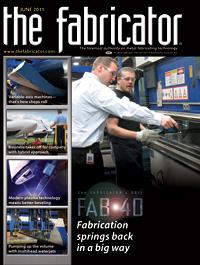Director of Engineering Services
- FMA
- The Fabricator
- FABTECH
- Canadian Metalworking
Categories
- Additive Manufacturing
- Aluminum Welding
- Arc Welding
- Assembly and Joining
- Automation and Robotics
- Bending and Forming
- Consumables
- Cutting and Weld Prep
- Electric Vehicles
- En Español
- Finishing
- Hydroforming
- Laser Cutting
- Laser Welding
- Machining
- Manufacturing Software
- Materials Handling
- Metals/Materials
- Oxyfuel Cutting
- Plasma Cutting
- Power Tools
- Punching and Other Holemaking
- Roll Forming
- Safety
- Sawing
- Shearing
- Shop Management
- Testing and Measuring
- Tube and Pipe Fabrication
- Tube and Pipe Production
- Waterjet Cutting
Industry Directory
Webcasts
Podcasts
FAB 40
Advertise
Subscribe
Account Login
Search
Get the most from your quoting software
6 tips to prevent you from reverting to money-losing estimating practices
- By Gene Barsaleau
- June 7, 2011
- Article
- Shop Management
For a portion of my 40-year manufacturing career, I was an estimator under duress, needing to quote parts or assemblies in a short amount of time or with limited information.
When that occurred, I was often plagued with the afterthought, "Did I miss something?" That led to another concern: "Did I overbid to give myself that safety cushion in case I did miss something?" Usually the answer was yes in both instances.
Would it have been helpful if the estimating job were given to someone else for review? Maybe. However, nine out of 10 times they would have done something differently.
Back in the day—the '70s, '80s, and '90s—every estimator put together his or her own "black book of knowledge" filled with standards, tables, and charts of machine cycle times, setup times, and material prices. The estimators frequently referred to this book as well as some set templates, process plans, and procedures.
If you were lucky, everyone had the same information. Of course, each estimator had additional information on top of that. That information was the liner notes of exceptions and rules that each estimator was able to extract from the minds of those on the shop floor, the people who were actually running the equipment. The problem with that was that not every operator provided the same information, and not everyone out there had the same experience.
Well, it's 2011, and those built-in inaccuracies are still with us because most companies are still estimating that way. That's not necessarily a bad thing. After all, experience is still a great means of developing an accurate estimate. The big problem is consistency. If a top estimator retires or changes positions, or if someone with little or no hands-on fabricating experience is hired, you can have a real mess on your hands. Not only does your consistency suffer and the speed for developing an estimate drop off, but that knowledge base has just taken a major hit. Now they have to rely on what others are telling them is the correct time or process.
The dawning of the computer age in the early '80s helped some companies with their estimating chores. If fabricators were fortunate enough to have a programming department that was willing to tear itself away from creating number-crunching financial reports for accounting, they may have enjoyed the use of some type of estimating program in basic programming language. The estimators and the financial wizards got together, laid out a format, and developed standards that everyone could agree to. One set of rules now applied to everyone in the quoting process.
Sure, that type of arrangement was still a bit cumbersome, and the rules constantly needed editing. But in the end, everyone was on the same page. If a part were given to two different estimators, they would get consistent results within a reasonable percentage.
From there, more and more companies started down that road of developing spreadsheet programs using consistent data and process templates. However, inconsistency started to raise its ugly head again. Each estimator thought he was building a spreadsheet program better than the next guy, and soon we were right back in the Stone Age of estimating again. Instead of doing it with a pencil, paper, and calculator, the estimators happened to be doing it with the aid of a computer.
In the next phase the database-driven estimating software emerged. This time all that knowledge developed over the years is stored in a series of centrally located databases that everyone can access. Meanwhile, only a handful of experts in the manufacturing facility have the knowledge to edit the databases.
In the end, no matter which estimating method you use, inconsistencies still can emerge. Even database-driven cost estimating software can fail if it isn't set up and implemented properly. If that happens, a fabricator can find itself back to using spreadsheets or, worse yet, paper, pencil, and calculator.
Quote the Estimator: Make the Software Work
A quoting software package doesn't have to be "shelfware"—at its most useful sitting on the bookshelf, not as part of a fabricator's IT system. These six tips can ensure that your company gets the most out of its quoting software:
1. Before you even purchase your software, know what it is that you need it to do for you. The system will need to be flexible and configurable to meet your company's requirements and be quick and easy to implement. A good estimating system should be able to incorporate your existing standards as well as come with its own industry-standard data that you can edit without having to go back to the software developer to make simple changes.
If you do need customization, is the software developer willing or even able to accommodate your requests? Also determine who will implement and maintain the software and who will use it. Oftentimes the failure of a system comes through neglect and lack of use. Are the users willing to use the system once it is in place?
2. Once the software is purchased, get the training. This cannot be stressed enough. The developers of the system should offer a comprehensive training program to get you started and to assist you in getting the most out of your software. Check out the developer, and ask for references. Make sure ongoing support will be available. If a user support group exists, join it. There should be many people out there using the system in similar ways as you.
3. Learn all you can about the system's capabilities. You may be looking for the system to give you just time and material calculations, but find out what else it can do. How can you use it to perform should costing—actually determining early during the design stage what the customer's part should cost? Many OEMS do not know why their suppliers are charging them what they do because they are not familiar with their processes. Set up a supplier's virtual plant in the software to get an idea how and why they charge what they do. If you have multiple locations and charge different labor rates at the different locations, set the work centers up for the different rates.
If the system has importing capabilities, use them. They are a great timesaver when it comes to loading the software with customer and vendor information and for loading and maintaining material and purchased item pricing.
4. Build master routing templates whenever possible. Why reinvent the wheel every time you prepare an estimate? Master templates can save as much as 90 percent of your estimating time on similar parts. Try to do that with your spreadsheet program.
If most of the parts or products that you manufacture require the same steps—such as laser cutting, brake bending, welding, grinding, prepping, and painting—create a master. This will help in at least two ways: It establishes a standard procedure, and it ensures consistency. Even the novice estimator now will know what steps need to be followed. Beyond that, you only need to read the drawing and put in the numbers.
5. Integrate with your enterprise resource planning (ERP) system. Why duplicate your efforts after you are awarded the job? You need to build a shop routing and bill of material to process the job, so why not import it from your estimating system? If you don't have a direct import/export function between software packages, check with your ERP system representative. The ERP software vendor is usually willing to work with the estimating software provider to help build that link. At the least, both systems usually can talk via a spreadsheet program—exporting from one system and then importing into the other using your spreadsheet as a "middleman."
6. Verify your data. As you continue to use your system, be on the constant lookout for inaccuracies within the software. Although your software probably has years of development behind it, system errors can occur. If you have maintained a good relationship with your software provider, they should be more than happy to work with you to change data. Things that cause problems for you will more than likely be problems for others. Don't be afraid to suggest system improvements and changes. All software developers rely on their end users to create a better, more useful product.
About the Author
Gene Barsaleau
59 Interstate Drive
West Springfield, WA 01089
413-733-1972
Related Companies
subscribe now

The Fabricator is North America's leading magazine for the metal forming and fabricating industry. The magazine delivers the news, technical articles, and case histories that enable fabricators to do their jobs more efficiently. The Fabricator has served the industry since 1970.
start your free subscription- Stay connected from anywhere

Easily access valuable industry resources now with full access to the digital edition of The Fabricator.

Easily access valuable industry resources now with full access to the digital edition of The Welder.

Easily access valuable industry resources now with full access to the digital edition of The Tube and Pipe Journal.
- Podcasting
- Podcast:
- The Fabricator Podcast
- Published:
- 04/16/2024
- Running Time:
- 63:29
In this episode of The Fabricator Podcast, Caleb Chamberlain, co-founder and CEO of OSH Cut, discusses his company’s...
- Industry Events
16th Annual Safety Conference
- April 30 - May 1, 2024
- Elgin,
Pipe and Tube Conference
- May 21 - 22, 2024
- Omaha, NE
World-Class Roll Forming Workshop
- June 5 - 6, 2024
- Louisville, KY
Advanced Laser Application Workshop
- June 25 - 27, 2024
- Novi, MI
































